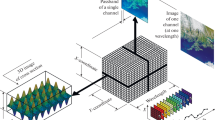Abstract
From the standpoint of the theory of statistical synthesis of information systems, the problem of determining the parameters of objects from the data of radar observations with a high rate of sounding and a change in perspective is considered. When developing a parametric model of signals from the observed objects, the approximation of local reflecting elements rotating around a certain axis was used, and the decorrelation of the received pulses was taken into account, due to inaccuracies in compensation of amplitude and phase changes, caused by the translational movement of the object. A general expression is obtained for the likelihood ratio as a function of the relative amplitudes and coordinates of the reflecting elements and the angular velocity of rotation. It is shown that the use of the criterion for the maximum of the likelihood function to determine the parameters of dominant reflecting elements in particular cases of quasi-coherent or incoherent pulses leads to the formation of sufficient statistics in the form of quasi-coherent or incoherent radar images, respectively. The results of computer simulation of the considered variants of the synthesis of radar images when processing a series of pulses under various conditions are presented.



Similar content being viewed by others
REFERENCES
D. R. Wehner, High-Resolution Radar (Artech House, Boston, 1995).
M. Cheney and B. Borden, Fundamentals of Radar Imaging (Soc. for Indust. and Appl. Math. (SIAM), Philadelphia, 2009).
V. C. Chen and M. Martorella, Inverse Synthetic Aperture Radar Imaging. Principles, Algorithms and Applications (Sci. Tech. Publ., Edison, 2014).
Radar Characteristics of Objects, Ed. by S. M. Nesterov (Radiotekhnika, Moscow, 2015) [in Russian].
A. A. Kuriksha, Proc. 3th All-Russ. Sci.-Tech. Conf. Radiotekh. Instit. im. Mintsa (MGTU, Moscow, 2015), p. 238.
A. A. Kazantsev, D. A. Perov, A. A. Samorodov, and B. A. Samorodov, Ural Radio Eng. J. 2 (2), 67 (2018).
V. G. Repin and G. P. Tartakovskii, Statistical Synthesis Under Prior Uncertainty and Adaptation of Information Systems (Sovetskoe Radio, Moscow, 1977) [in Russian].
Ya. D. Shirman and V. N. Manzhos, Theory and Technology of Radar Information Processing in the Presence of Noise (Radio i Svyaz’, Moscow, 1981) [in Russian].
Radar Handbook, Ed. by M. I. Skolnik, Vol. 1: Fundamentals of Radiolocation (McGraw-Hill, New York, 1970; Sovetskoe Radio, Moscow, 1976).
Radar Cross Section. Handbook, Ed. by G. T. Ruck, (Plenum, New York, 1970).
V. O. Kobak, Radar Reflectors (Sovetskoe Radio, Moscow, 1975) [in Russian].
J. B. Keller, J. Opt. Soc. Am. 52 (2), 116 (1962).
P. Ya. Ufimtsev, Theory of Edge Diffraction in Electromagnetics (BINOM. Laboratoriya Znanii, Moscow, 2012) [in Russian].
A. A. Kuriksha, Radiotekh. Elektron. (Moscow) 13, 771 (1968).
Author information
Authors and Affiliations
Corresponding author
Ethics declarations
The author declares that he has no conflict of interest.
Rights and permissions
About this article
Cite this article
Lagutkin, V.N. Statistical Synthesis of the Algorithm for Formation of Radar Images of Objects Accounting for Pulse Decorrelation. J. Commun. Technol. Electron. 67, 156–163 (2022). https://doi.org/10.1134/S1064226922020103
Received:
Revised:
Accepted:
Published:
Issue Date:
DOI: https://doi.org/10.1134/S1064226922020103



